Facebook is a long range interpersonal communication site where clients can post remarks, share photos and present connections on news or other intriguing substance on the web, visit live, and observe short-shape video. You can even request sustenance on Facebook if that is the thing that you need to do. Shared substance can be made openly available, or it tends to be shared just among a select gathering of companions or family, or with a solitary individual.
How It Began
Facebook started in February of 2004 as a school-based interpersonal organization at Harvard University. It was made by Mark Zuckerberg alongside Edward Saverin, the two understudies at the school. It wasn't until 2006 that Facebook opened to anybody 13 years or more seasoned and took off, quickly overwhelming MySpace as the most mainstream informal organization on the planet.
Facebook's prosperity can be credited to its capacity to engage the two individuals and organizations and its capacity to associate with destinations around the web by giving a solitary login that works over numerous locales.
Attractions of Facebook
Facebook is easy to use and open to everybody. Indeed, even the minimum specialized disapproved of individuals can join and start posting on Facebook. In spite of the fact that it began as an approach to stay in contact or reconnect with departed companions, it quickly turned into the sweetheart of organizations that had the capacity to nearly focus on a group of people and convey advertisements specifically to the general population well on the way to need their items or administrations.
Facebook makes it easy to share photographs, instant messages, recordings, status posts and sentiments on Facebook. The site is engaging and a standard every day stop for some clients.
Not at all like some informal community destinations, Facebook does not permit grown-up substance. At the point when clients transgress and are accounted for, they are prohibited from the site.
Facebook gives an adaptable arrangement of security controls, so clients can shield their data from getting to outsider people.
Facebook has opened up Instant Articles to publishers of all sizes. In this post, we’ll guide you through the ins and outs of Facebook’s publishing platform and how to get started.
The announcement that Instant Articles were being opened up to all publishers came in February 2016, and they were officially opened for all on April 12, at Facebook’s F8 conference.A Facebook-native publishing platform has been rumored since the social network changed its News Feed algorithm to favor “quality content” in 2013. Since that update, Facebook has become one of the top referrers of traffic to news sites and blogs of all sizes, and in the summer of 2015, traffic analytics company Parsely revealed that Facebook had even overtaken Google as the number 1 referrer of traffic to news sites.
Before launch over 1,000 publishers were testing the platform and as its rolled out to everyone we’re excited to learn:
- How can you get started?
- How they work?
- How much engagement do they receive?
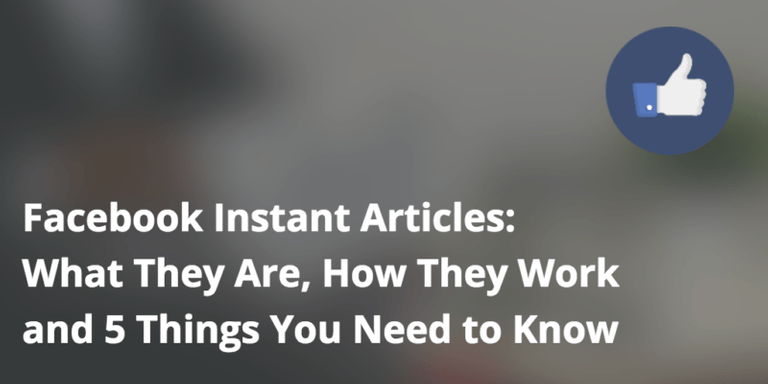
First off: What are Instant Articles?
Instant Articles were built to solve a particular problem—slow loading times on the mobile web.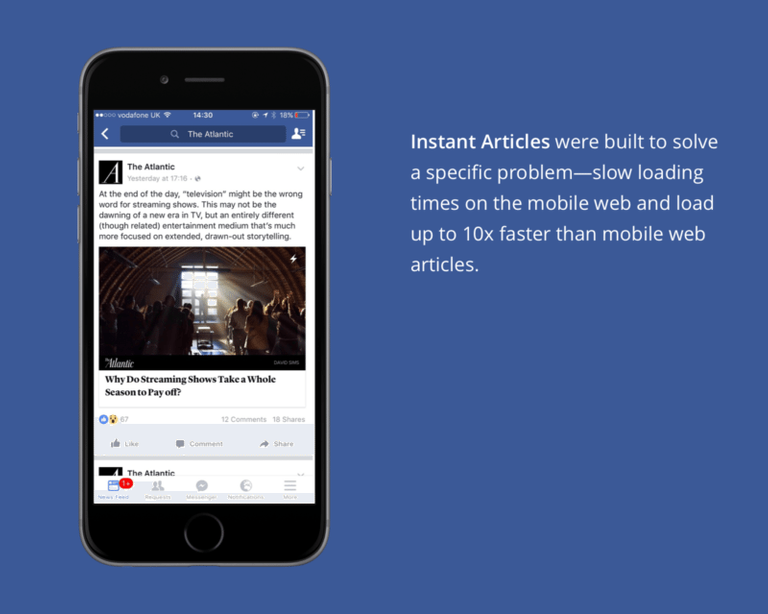
The Facebook-native publishing platform includes a whole host of interactive features that help stories come to life on mobile, including auto-play video and tap-to-zoom image galleries.
Josh Roberts, Product Manager at Facebook explained more about the format in a post on the Facebook blog:
Facebook’s goal is to connect people to the stories, posts, videos or photos that matter most to them. Opening up Instant Articles will allow any publisher to tell great stories, that load quickly, to people all over the world. With Instant Articles, they can do this while retaining control over the experience, their ads and their data.The platform has been in testing with selected partners since May 2015, and the data so far feels encouraging:
- Instant Articles received 20% more clicks than mobile web articles from the News Feed
- Once someone clicks on an Instant Article, they’re 70% less likely to abandon the article before reading
- They are shared 30% more than mobile web articles on average
 Facebook also discovered that people on slower connections read 20-40% more Instant Articles than mobile web articles on average.
Facebook also discovered that people on slower connections read 20-40% more Instant Articles than mobile web articles on average.How to create Instant Articles
Step 1: Sign up
The first thing you need to do to get up and running is sign up to join the program. You can do this at instantarticles.fb.com.Note: To begin publishing, you must have an existing Facebook Page and have Admin or Editor role on the Page.
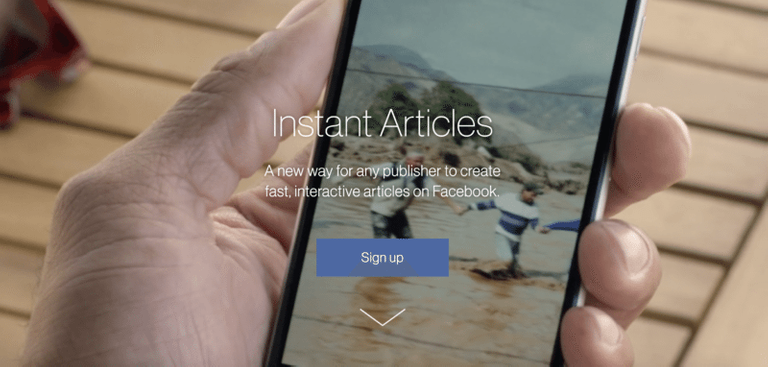
Step 2: Choose your Facebook Page
After signing up you’ll be given the chance to choose which Page you’d like to activate articles for:
Step 3: Claim your URL
Once you’ve selected your Facebook Page, you’ll be asked to provide a URL you intend to use for articles. This URL will serve as the basis for the URLs of all your posts (and, in most cases, will be your blog URL, for example, buffer.com/library).To claim your URL you need to add a meta tag to your HTML’s <head> tag and then add the URL to your settings. All the information you need to do this can be found in the Instant Articles Settings:

Step 4: Create articles
In testing, Facebook discovered that publishers want a single tool to publish articles to the web, mobile apps, or any other places readers see their content. As such, articles can be published directly from your Content Management System — there’s no need to re-create articles within Facebook.You can sync your blog with Instant Articles via Facebook’s publishing tools, an RSS feed or by using an API. Here’s a quick rundown of the options available:
Connecting with WordPress
If you use WordPress to power your blog, Facebook has created a plugin to streamline the process of creating Instant Articles. This is likely to be the quickest and easiest way to get set up with Instant Articles.Publishing tools
Alongside the WordPress plugin, Facebook has teamed up with many publishing platforms to create seamless integration with Instant Articles.Publishing Tools includes integrations with:
- Drupal, Atavist, Medium, Perk Distributed, RebelMouse, ShareThis, Sovrn, Steller, Tempest. Find the full details here.
RSS feed
If you aren’t using WordPress or another CMS supported by Facebook Publishing Tools, you can connect your content to Facebook through an RSS feed.An RSS feed can integrate seamlessly with Facebook with new posts being automatically syndicated as Instant Articles whenever you hit publish.
To enable publishing from an RSS feed, you must configure your content management system to generate a new RSS feed which contains the full content of each article in Instant Articles markup (you may need a developer to help with formatting the feed).
➤ A guide to formatting RSS feeds in Instant Articles markup can be found here.
API
The API allows you to create, publish, update and delete Instant Articles directly from your content management system and provides an excellent alternative to connecting via RSS.
➤ A guide to using the Instant Articles API can be found here.
Step 5: Customize styling
Facebook gives you the option to customize the styling of your articles during setup; here you can upload a logo and select which fonts are used throughout your articles. Font choices are currently limited to the Helvetica Neue and Georgia font families.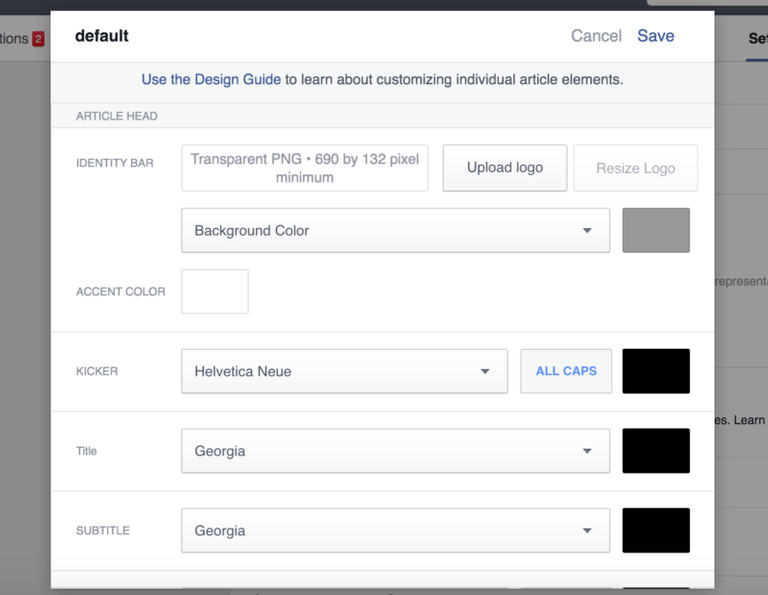
Step 6: Submit for review
After you’ve completed the above steps you can submit your feed to be reviewed by Facebook to verify that all articles generated from your website are properly formatted.Facebook currently aims to review all submissions with 24-48 hours.
Useful resources:
➤ Instant Articles developer docs➤ Instant Articles blog
5 things you need to know about Instant Articles
1. You can monetize Instant Articles
Publishers can drive revenue from their content. If you sell the ads in your content, Facebook is giving publishers 100% of the revenue and is taking 30% cut if the ads are sold through the Facebook’s Audience Network.Facebook’s Audience Network offers publishers the opportunity to leverage the power of Facebook ads to monetize their content, and when you get started with Instant Articles you have the opportunity to opt-in to Audience Network ads:

If you sell your own ads, you’re able to serve video ads, animated ads and banner ads within articles. More information on integrating your ads can be found in the Facebook Developer Docs.
2. Building an Instant Article doesn’t create a post from your Page
When you publish an Instant Article, it doesn’t automatically create a corresponding Facebook post from your page. What happens is that any time a reader on a mobile device is directed to the article’s URL on Facebook, the link will be displayed as an Instant Article, instead of loading up in a mobile browser.3. Quicker loading speeds can increase readership
Load speed is incredibly important for any blog, and Instant Articles can load up to 10x faster than mobile web articles. As mentioned a little earlier, the super-fast load speed or instant articles leads to 70% less abandonment and 20% more clicks.The average attention span is down to just eight seconds online, which means faster loading times are a huge advantage when readers are eager to access content in an instant.
4. You’re in control of which posts are published
Once you get set up with Instant Articles, you’re 100% in control of which articles you share to Facebook. This means you can republish every article from your blog, or just a select few – as more data becomes available it’ll be interesting to keep an eye on strategies here and see what performs best.You can control which articles you publish to Facebook from your Library. To view your library, click Publishing Tools from the top of your Facebook Page and then select Instant Articles from the menu on the left of the screen.
The Instant Articles library looks like this:

From here you can edit articles and choose which of your drafts to publish.
5. You can add email sign up forms to articles
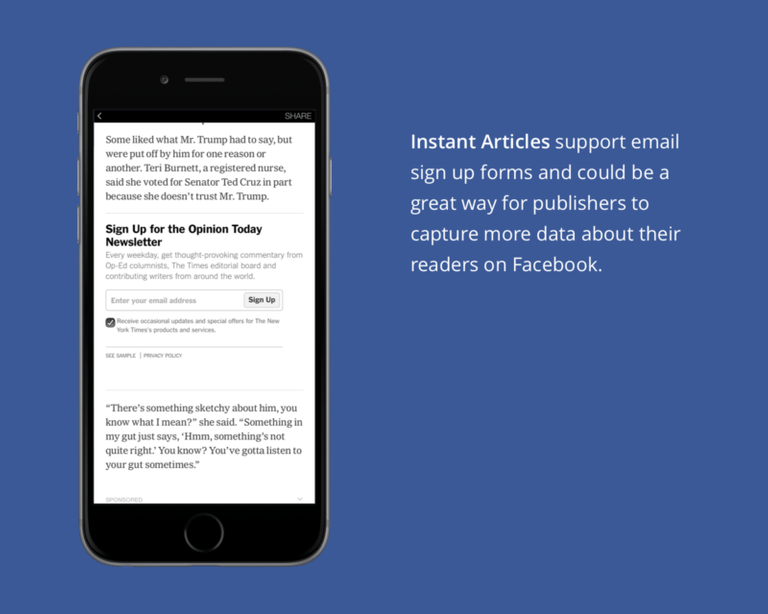
Email capture is a vital part of many content marketing strategies, and losing out on potential subscribers is a fear that Facebook have addressed by enabling email capture within articles.
“One of the other things we heard is that publishers want to build a more direct relationship with their readers through Instant Articles, and one way to do that is through more regular contact with those readers.” Facebook said in a statement.
Over to you
As with any publishing platform, the value of Facebook Instant Articles greatly depends on your business model and goals.At Buffer, we’re excited to test out the platform and see whether articles can increase the reach of our content and also our conversions. Traffic from Facebook is one of our highest converting sources, and I’m curious how Instant Articles may affect conversions going forwards. We’ll be sure to keep you posted. 🙂
As always, feel free to share your thoughts in the comments. I’d love to hear your views on Instant Articles and whether you’ll be using them for your business or blog?
(html comment removed: AddThis Advanced Settings above via filter on the_content )(html comment removed: AddThis Advanced Settings below via filter on the_content )(html comment removed: AddThis Advanced Settings generic via filter on the_content )(html comment removed: AddThis Share Buttons above via filter on the_content )(html comment removed: AddThis Share Buttons below via filter on the_content )
Originally written Apr 13, 2016. Last updated Nov 30, 2018
Sign Up for Instant Articles
Set up your account and get access to publishing tools:- Log in to your Facebook account and go to Sign Up for Facebook.
- Select the Facebook Page that you’d like to use to manage your Instant Articles.
- Agree to the Instant Articles Terms, which contain our content and advertising policies.
- To access the tools, click on Publishing Tools on your Facebook Page, and go to Instant Articles in the left navigation bar.
Develop and Submit Your Sample Articles
Import articles from your content management system and render them as Instant Articles:- Upload your logo and create customized styles to reflect your publication’s look and feel.
- Import your articles with the Instant Articles API or an RSS feed and create templates for your article markup. Or, if you use a third-party publishing platform like WordPress, check for one of the easy-to-use plugins maintained by our partners.
- See how your articles render by using Facebook’s Pages Manager app for iPhones or Android devices.
- Submit a batch of articles for review—the Instant Articles team will approve it or ask you to make updates so your articles follow content and advertising policies.
Begin Publishing
Give your mobile readers an experience that is beautiful, fast and immersive:- Use the auto-publish setting for RSS feeds so that all your articles load as Instant Articles in Facebook.
- Rely on the Instant Articles Developer blog for new features and updates: developers.facebook.com/ia/blog.
- Continue to analyze your traffic and engagement and publish Instant Articles to see how the experience grows your readership on Facebook. To see the maximum benefits of the program, we recommend publishing 100% of your content as Instant Articles.
Sponsored ( Powered by dclick )
Join the Steemmonsters frenzy
Get in the game🙂 Steemmonsters is a fully decentral...

This posting was written via
dclick the Ads platform based on Steem Blockchain.
Ho! Ho! Ho! Merry Christmas!! I've given you an upvote and left you this amazing automated comment!!
Thanks man. I really need your mentorship
Hi! I am a robot. I just upvoted you! I found similar content that readers might be interested in:
https://blog.bufferapp.com/facebook-instant-articles
img credz: pixabay.com
Nice, you got an awesome upgoat, thanks to @mrsummist
BuildTeam wishes everyone a great Christmas and bullish Holidays
Want a boost? Minnowbooster's got your back!
Congratulations @mrsummist! You have completed the following achievement on the Steem blockchain and have been rewarded with new badge(s) :
Click here to view your Board
If you no longer want to receive notifications, reply to this comment with the word
STOP